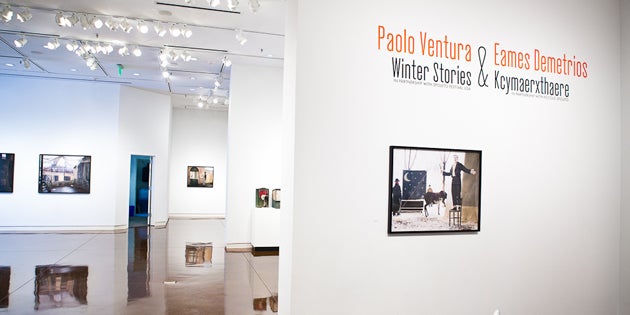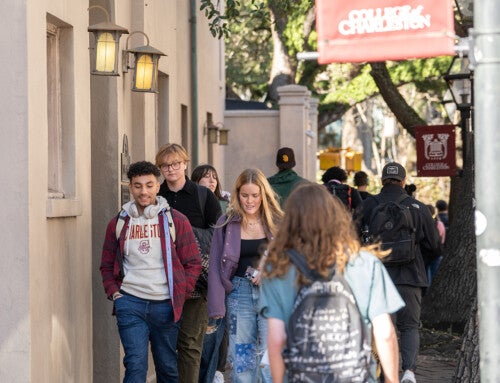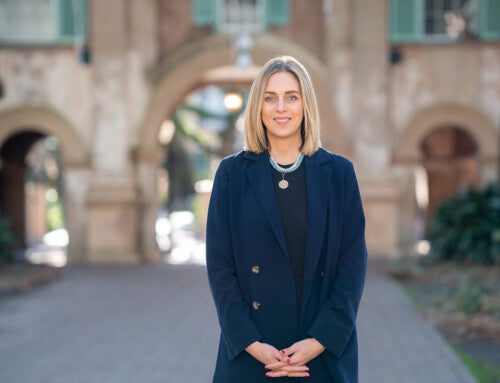“Sixteen years ago I was given a summer internship at the Halsey Institute that led to an unbelievably direct and lasting legacy on my career.”
-Caroline Wright, curator of the True F. Luck Gallery at the Visual Arts Center of Richmond
 The Halsey Institute of Contemporary Art at the College of Charleston and Director Mark Sloan have served as a springboard for the careers of hundreds of students. Former Halsey Institute interns are working at galleries and art organizations all over the U.S. and abroad, including the Metropolitan Museum of Art, the National Gallery and the High Museum in Atlanta.
The Halsey Institute of Contemporary Art at the College of Charleston and Director Mark Sloan have served as a springboard for the careers of hundreds of students. Former Halsey Institute interns are working at galleries and art organizations all over the U.S. and abroad, including the Metropolitan Museum of Art, the National Gallery and the High Museum in Atlanta.
“We produce ambitious projects with national significance with a small but nimble staff and a dedicated group of constantly changing interns,” says Mark Sloan, director of the Halsey Institute
Becoming Proficient in General Usefulness
The Halsey Institute usually has five interns each semester (and during the summer), and provides real world experience, making interns part of the team. The interns also select an area of concentration like curatorial research, grant writing, event planning, or marketing.
RELATED:What’s coming up next at the Halsey Institute?
“My internship was helpful with everything from the logistics of hanging a show to fundraising,” says Alix Refshauge ’07 (M.P.A.), now the research and special projects associate for the Alliance of Artists Communities in San Diego. “Seeing the Halsey’s annual fundraiser, the way they approach the City of Charleston for funds, and gaining an understanding of how Mark Sloan got the Force of Nature exhibition funded was all really impactful for me when I was running an artists-in-residence program. Money doesn’t just come to you because you’re doing compelling things.”
Sloan also tries to instill the concept of “general usefulness.” Most galleries and art-related non-profits where students will launch their careers have small staffs, so everyone needs to be “generally useful” to the overall enterprise, in addition to their specialized function.
RELATED: Learn more about Mark Sloan and his advice for future curators.
It’s tasks related to this concept of “general usefulness” that many interns remember.
“My most memorable moment from my internship was pulling rotten carrots and burned matchsticks out of the walls for days (and days and days) after The Art Guys exhibition closed,” laughs Caroline Wright.
Charles Ailstock ’00, owner of Artizom Frame Gallery, remembers gathering materials and helping Brooklyn artist Gene Pool assemble his show of suits. “That was a definite highlight. I drove him out a locksmith in North Charleston so that we could sift through buckets of discarded keys to find the right shape and color to cover his suit.”
International Experience
Exhibitions and events at the Halsey Institute are often global, so it makes sense that the internship program would be as well. Every year, there is an international intern for the summer. Private donations pay for the intern’s airfare, a modest per diem, and housing. Interns have come from Switzerland, Poland, Austria, France, Canada, Japan, and Korea (among others) over the past 20 years.
RELATED:Watch a video about Japanese artist Motoi Yamamoto’s exhibit at the Halsey Institute.
This summer Tomoko Watarikawa has spent three months interning at the Halsey Institute. She’s earning her master’s degree in museum education from Kyoto University. Her internship has been tailored to education, where she works with Lizz Biswell, curator of education and public programs, to develop activities and tour topics related to the current Shepard Fairey and Jasper Johns show.
“Just having various experiences with the arts in the U.S. will help my career,” explains Watarikawa. “I’ve been able to study the behavior of several hundred visitors to the Halsey Institute and compare it with Japan. Plus, I’ve been able to meet a lot of people and I really enjoy Charleston’s history, culture, food and discussions with many people every day!”
Internship to Career
This internship is one that truly prepares students for meaningful careers.
“I’m now framing and handling high-end artwork for galleries and private collectors in South Carolina, so all the installations and signage work at the Halsey really prepared me,” explains Ailstock, now a member of the Halsey Institute’s advisory board.
“On my first day of my current job in January of 2011, I called on Mark because I inherited a program with no exhibition schedule on the books, starting two months after my arrival,” Wright says. “Mark immediately suggested his newest traveling exhibition of paintings by Leslie Wayne, and we installed it in April.”
RELATED: A former Halsey Institute intern is working at The Met.
Sloan says it was his own internship experience that motivated him to help the next generation of museum professionals.
“Thirty years later, I am still continuing the tradition of creating opportunities and incubating new talent in the field.”





